PinotFile: 8.41 July 23, 2011
|
A Trip Well Taken
But you can never leave!” Hotel California, The Eagles There are many wine regions in California that produce Pinot Noir of uncommon richness, but there is only one that has a major river running through it that defines its very existence. The Russian River Valley is 1,485 square miles of wilderness, farmland, towns and cities that lie in the Russian River watershed. Vintners here like to say that fog makes the Pinot Noir and it is the regular intrusion of cooling fog from the Pacific Ocean through the Petaluma Wind Gap a few miles to the west of the Russian River Valley and through the channel cut by the Russian River that allows Pinot Noir to develop intense flavor maturity over an extended growing season. It would almost seem that the River gives Russian River Valley Pinot Noir its spirit. For me, I am drawn back to the Russian River Valley for the lifestyle built around great Pinot Noir, food and wine country living. The combination of farmers’ markets, reservation-only restaurants, roadside taverns and winery dining are all part of the tapestry of life along the Russian River Valley. It is one of those magical places that you never really leave even as you reluctantly slide into your car for the trip home. Each year as part of ¡Salud! The Oregon Wine Auction, I donate a hosted “Russian River Valley Immersion Weekend” for four people. ¡Salud! is uniquely Oregon and represents a collaboration between Oregon winemakers and healthcare professionals to provide access to health care for Oregon’s seasonal vineyard and winery workers and their families. A dedicated group of vintners and Tuality Healthcare physicians created ¡Salud!, named for the traditional Spanish toast, “To your health!” This year’s ¡Salud! Tasting and Big Board Auction will be held November 11 and the Dinner and Auction Gala on November 12. Recently, I hosted brothers Bill and Michael Sweat. Bill, along with Donna Norris, is the proprietor of Winderlea Wine Co., a boutique winery in the Dundee Hills of Oregon, and Michael is a business executive from Boston, Massachusetts. We drank more great Pinot Noir and ate more incredible food than we deserved, but someone had to do it.
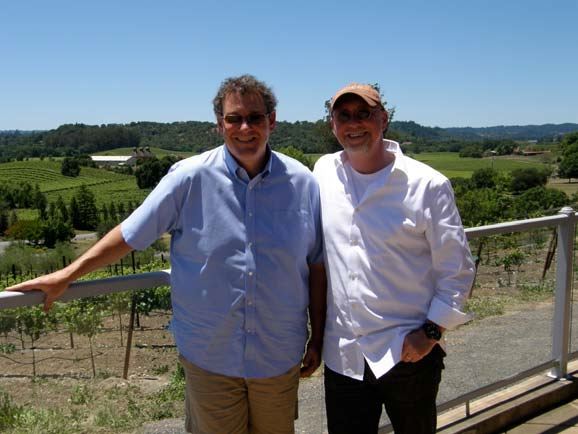 The gracious hosts at the wineries we visited gave generously of their time and we remain especially grateful to Bob Mosby at Benovia, winemaker Ben Cane at Twomey, winemaker Ted Lemon of Littorai, winemaker Kathleen Inman of Inman Family Wines, and winemaker Eva Dehlinger of Dehlinger, as well as the hospitality staffs at Lynmar, Dutton-Goldfield and Russian Hill.
Thursday
After the Sweats settled into the Benovia Vineyard Hideaway Guest Cottage overlooking the winery’s Martaella Vineyards, we met with Sales Director Bob Mosby in the new Benovia hospitality center to sample the lineup of 2009 Benovia wines. Bob is well known in the Russian River Valley wine community after working ten harvests at Williams Selyem and several more at Brogan Cellars. Bob came to Benovia from Phoenix, Arizona, where he had met proprietors Joe Anderson and Mary Dewane who had successful careers in the health care industry. Benovia’s winemaker, Mike Sullivan, grew up in the Russian River Valley area, graduated with a degree in fermentation science at Fresno State, and has crafted wines on the Sonoma Coast since 1987. He has been the winemaker at Benovia since its first vintage in 2006 and is extremely well respected in the Sonoma County winemaking community. Benovia harvests grapes from 71 planted acres in both the Russian River Valley and Sonoma County AVAs. The estate vineyards include Cohn Vineyard (18 acres), Martaella Vineyards (41 acres) and Falstaff Road Vineyard (12 acres).
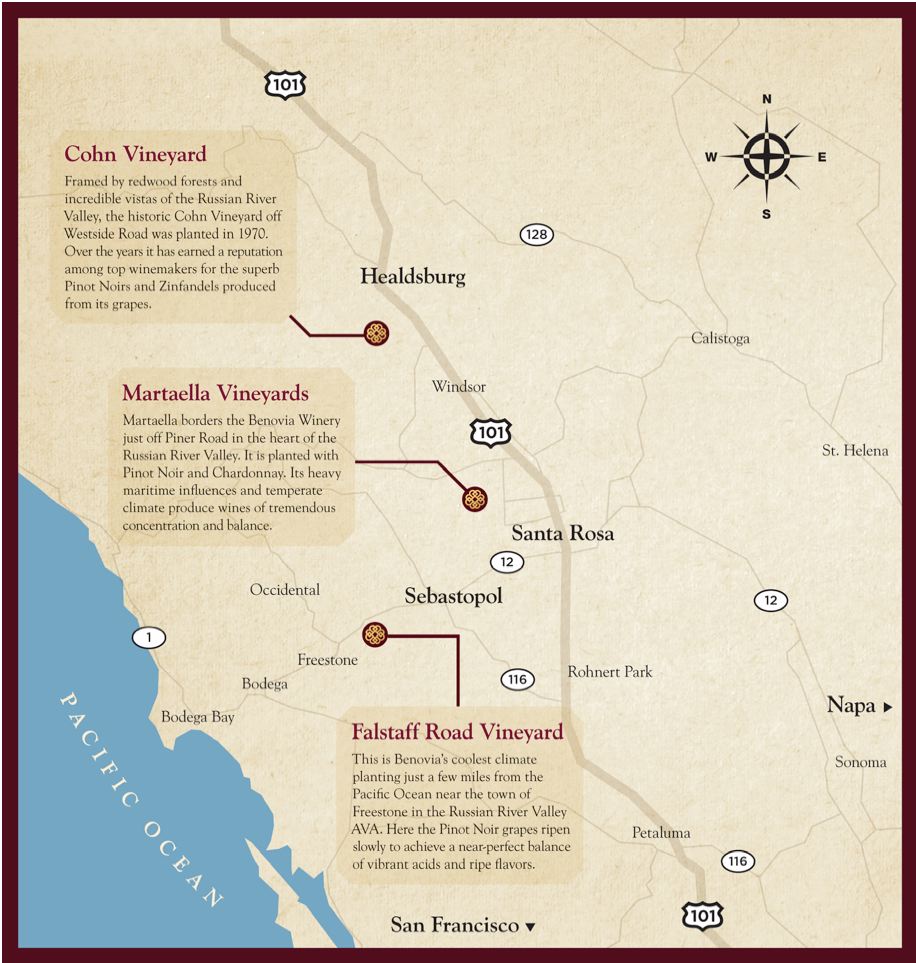 Grower partners include Martinelli Vineyards, Savoy Vineyards, Manzana Vineyard/Dutton Ranches, Petersen Vineyard and Four Brothers/Sullivan Vineyard. Winemaking for Pinot Noir, Chardonnay and Zinfandel are traditional. The Pinot Noir grapes are harvested whole cluster, hand sorted, de-stemmed and then berry sorted. Small amounts of whole cluster are included. Pre-fermentation cold maceration lasts 5-8 days, followed by indigenous yeast fermentation and a long, slow inoculated malolactic fermentation with weekly lees stirring. The wines spend 14 to 16 months in French oak barrels (Francois Frères, Rousseau, Remond and others) before they are bottled and labeled at the winery. The quality has always been high at Benovia, but after tasting through the 2009 vintage lineup, I felt these were the best wines Sullivan has crafted there. Even Sullivan, who is conservative and not one to tout his wines, has raved about the 2009 vintage, calling them “elegant and expressive.” The summer of 2009 saw moderate heat from August through harvest resulting in perfect physiologic grape ripeness. The 2009 Pinot Noirs are generally more approachable than the 2008 versions, possessing less tannin, and more charm. The current spring releases include a Sonoma Coast and Russian River Valley Pinot Noir blend, a Sonoma Mountain Chardonnay and “La Pommeraie” Russian River Valley Chardonnay. All alcohols for the 2009 vintage are 14.1%-14.2% except the Zinfandel which is 15.8%. The vineyard-designate Pinot Noirs will be released in the fall. Total production in 2009 was about 3,500 cases. The wines are sold primarily through a mailing list at www.benoviawines.com, but may be purchased through the winery’s website store. Tasting at Benovia is by appointment. Note: there are still a few bottles of the 2007 Benovia Sonoma Coast Pinot Noir ($45) available from the winery. The wine is now drinking in its prime with plenty of appealing flavors of black cherries, cola and sassafras.
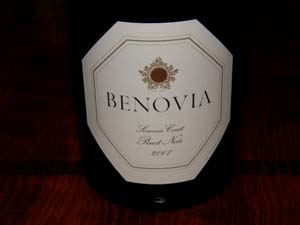 2009 Benovia Sonoma Coast Pinot Noir 14.2% alc., pH 3.68, TA 0.59, 820 cases, $38. Released March2011. Primarily Petersen Vineyard with lesser amounts of Dutton Manzana, Martaella, and Martinelli vineyards. A combination of heirloom selections and Dijon clones. Aged 17 months in 45% new French oak barrels. · Nicely perfumed with aromas of black cherries and baking spice. Highly approachable and very tasty array of dark fruits with supple tannins. A stellar daily drinker for current consumption. Very good.
2009 Benovia Russian River Valley Pinot Noir 14.1% alc., pH 3.62, TA 0.61, 120 cases, $45 (nearly sold out). Released March 2011. Primarily Pommard clone from Martaella Vineyard. Aged 17 months in 40% new French oak barrels. · Bright aromas of dark red fruits with a hint of savory herbs. A little heftier than the Sonoma Coast bottling with a juicy core of dark red cherries and berries and a rif of herbs and spice. Good.
2009 Benovia Savoy Vineyard Anderson Valley Pinot Noir $56. · This wine is filled with charm offering aromas of black cherries and baking spices and flavors of black raspberries and juicy red plums all wrapped in soft tannins and framed in bright acidity. The mouth feel is pure silk. Quite precocious for Savoy Vineyard, but the wine’s perfect balance will lead to a long cellar life. Very good.
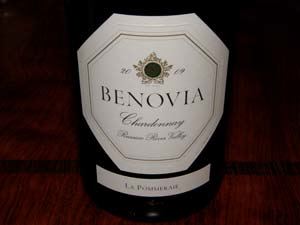 2009 Benovia Cohn Vineyard Sonoma County Pinot Noir $62. A historic vineyard first planted to Pinot Noir and Zinfandel in 1970. An unlikely pairing in the same vineyard, but the owners planted what they wanted to drink. Over the years, grapes went to Williams Selyem and Kosta Browne. Joe Anderson and Mary Dewane purchased the 55-acre ranch in 2002. Today, the vineyard is 6.5 acres planted with clones of unknown origin, possibly Pommard and Martini. In 2006, Benovia undertook an extensive pruning of the vineyard to reduce clusters and intensify flavors. · A remarkable wine offering alluring aromas of spicy, earthkissed red and black berries that intensify over time in the glass. Delicious essence of black raspberries and black cherries with exotic spice notes. Soft and silky in the mouth with a generous finish that is memorable for its length. A complete wine. Very good (+).
2009 Benovia Bella Una Russian River Valley Pinot Noir $56. An hi-end blend from the different subregions of the Russian River Valley (Green Valley, Middle Reach and Laguna de Santa Rosa). Clones 115 and 828 primarily from Seven Mules and Manzani vineyards. · Vibrant scent of mixed berries, sandalwood and Asian 5-spice. A very elegant and sophisticated wine with crisp dark red cherry and berry flavors filling the mid palate with joy and softly exiting with aromatic intensity. Very good.
2009 Benovia La Pommeraie Russian River Valley Pinot Noir $56. Sourced from a Martinelli Family vineyard in the Russian River Valley which at one time was an apple orchard (thus the name, “La Pommeraie,” French for apple orchard). Clones 777 and 828. · This is the one wine in the 2009 lineup that is relatively closed. We initially pulled the cork and found the wine reluctant, and an hour and a half later, it had just begun to open. Fruity aromas augmented by scents of spice and graham. Flavors of dark plums and black cherries framed by firm tannins. My least favorite in the lineup now, but time in the cellar will undoubtedly change the experience. Good.
2009 Benovia Sonoma Mountain Grenache A small production item from winemaker Michael Sullivan’s family vineyard. · Intensely fruity with a rich core of red and black berries, black currants and mu shu plum sauce backed by ripe, muscular tannins. Good.
2009 Benovia Sonoma County Zinfandel 500 cases, $38. · A cooler weather styled Zinfandel that drinks more like a Pinot. Despite its hefty alcohol, the wine is light on its feet and not jammy with bright purple fruits, especially blackberries, with hints of white pepper and restrained fine tannins. Quite a delightful drink. Very good.
2009 Benovia Sonoma Mountain Chardonnay 14.2% alc., pH 3.48, TA 0.63, 120 cases, $32. Released March 2011. From the Four Brothers Sullivan Vineyard on the western slope of Sonoma Mountain. Whole cluster pressed and fermented with indigenous yeast. 100% MLF. Aged 16 months in 40% new French oak barrels. Old Wente clone. · Tropical fruit spirited with added aromas and flavors of blood oranges, pears, oak spice and vanillin. Not a wine to contemplate, but one to enjoy for its up front charm. Good.
2009 Benovia Sonoma Coast Chardonnay $48. From one of Lee Martinelli’s vineyards. Aged 14 months in 45% new French oak barrels. · A classic Chardonnay with striking aromas and flavors of fresh apples and candied citrus. Very crisp and bright on the palate with a juicy, dry finish. Very good.
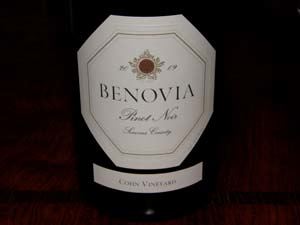 2009 Benovia La Pommeraie Russian River Valley Chardonnay 14.5% alc., pH 3.31, TA 0.79, 470 cases, $48. Released March 2011. From the Frei Road Vineyard owned and farmed by George Martinelli. The vineyard is closely planted with a very high density of 2,420 vines per acre. A blend of Dijon 95 and 548 clones. Whole cluster pressed, indigenous yeast fermentation and weekly lees stirring. Aged 16 months in 47% new French oak barrels. · The most intense Chardonnay and always my favorite in the Benovia Chardonnay lineup. Lovely aromas of citrus peel, baked pear and honeysuckle. Slightly creamy on the palate, with crisp flavors of apples, pears and lemons with a minerally undertone. An hi-collared offering that will please any Chardonnay aficionado. Very good (+).
Friday
We met with winemaker Ben Cane, toured the expansive winery and tasted through the lineup of 2009 Pinot Noirs and the 2010 Twomey Sauvignon Blanc. Under the direction of Cane, Twomey intends to produce Pinot Noirs that rival their lofty and iconic neighboring wineries on Westside Road and the 2009 vintage wines are proof that the winery is on the right track. Cane is an Aussie who has traveled and worked all over the world including winemaking stints at Domaine Dujac in Morey-St.-Denis and Arcadian Wines in Santa Barbara County. His stylistic goals clearly reflect the influence of Jeremy Seysses and Joe Davis. The Twomey Pinot Noirs are intended to be refined and food-friendly and to be enjoyed shortly after release, while still possessing the structure and balance to age.
 Twomey Cellars focus is blended appellation-designated Pinot Noir, although the Central Coast bottling is now entirely from Bien Nacido Vineyard Block N. The Anderson Valley Pinot is primarily sourced from the Monument Tree Vineyard (which Twomey has purchased), the Sonoma Coast offering is anchored by Gap’s Crown Vineyard, and the Russian River Valley Pinot Noir mainly features fruit from the Twomey estate WestPin Vineyard located in the Middle Reach along Westside Road. Cane has a total of 9 vineyards and 39 separate wines with which to create his Pinot Noir blends. He also crafts the Twomey Sauvignon Blanc. More detailed coverage on Twomey Cellars including my tasting notes on the 2009 Pinot Noirs is available from a recent PinotFile article I wrote after visiting previously: http://www.princeofpinot.com/article/1057/. The 2010 Twomey Sauvignon Blanc is sourced from a vineyard in Calistoga and is vinified one-third in barrel, one third in tank and one-third in drums. At 13.4% alc., this Sancerre-styled Sauvignon Blanc is crisp and fruity with tropical melon, green apple and lime flavors unencumbered by any herbal and vegetal notes that this varietal can exhibit. Twomey Cellars Pinot Noir and Sauvignon Blanc are available at the winery, fine wine retail outlets, and better restaurants. The website is www.twomeycellars.com. The tasting room is open daily and offers spectacular views of the Russian River Valley.
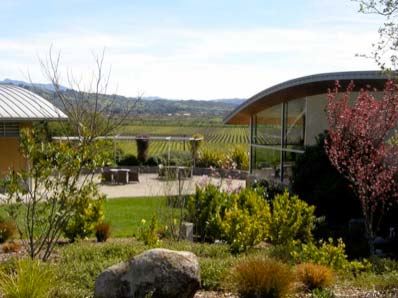 Our group, including Ben Cane, headed for lunch at Bistro Ralph on the Healdsburg Square. This is a longstanding treasure in Healdsburg known for its French bistro cuisine. I have never been there for lunch when I haven’t run into a winemaker or two. If you go, don’t miss the Lamb Burger, the grilled albacore sandwich, the snap peas or the Plate of 1,000 Fries (thin fries piled 18” high on a plate). The 2009 Twomey Anderson Valley Pinot Noir was the perfect accompaniment to our lunch. The restaurant's website is www.bistroralph.com. Ben shared a couple of insights with us over lunch. He is a fan of using whole clusters and finds that putting stems (whole clusters) in the bottom of the fermenting tank creates an anaerobic environment whereby the stems become riper (Don’t ask me how). In addition, in striving for ripe phenolics in Pinot Noir without high sugars, he has discovered that it is beneficial to open the trellis and allow the canopy to be more sprawling. This lets more sun through without producing ripe flavors produced by heat.
After a short drive to Sebastopol, we met with Littorai proprietor and winemaker Ted Lemon at his 30-acre estate vineyard and winery. I have seen the development of this property and winery from the beginning, having visited on several occasions. His new winery, which opened in 2010, was a goal since Littorai’s inception in 1993 when 12 barrels of wine were crafted in the back of Robert Pecota Winery. This environmentally sensitive winery incorporates straw bale construction and incorporates gravity flow on its two levels. All the process waste from winemaking is recycled through a constructed wetlands system and recycled for vineyard and property irrigation. Natural lighting is employed with strategically placed windows reducing the need for electricity. Ted’s years in France led to his philosophy of winegrowing based on the concept of terroir and the practice of biodynamic farming. The estate Pinot Noir vineyard (Pivot Vineyard) is farmed using only organically certified materials and the farm is integrated, diversified and self-sustaining. Ted’s property is almost magical in its serenity yet vibrant with healthy plant life in abundance, tall crop cover between vineyard rows, a large compost pile (photo below), and strategically placed plantings to attract beneficial insects, control erosion, nourish the soil, and add visual appeal. I have never seen another farm estate quite like it in my extensive wine region travels. Ted has added to the property slowly, carefully and deliberately, with the goal of achieving a self-contained farm and with an intent to minimize or eliminate undesirable inputs. He plans to eventually add some cattle to his farm to provide the manure and horns for field preparations. The compost preparations originate on the property. Ted has not sought out organic or biodynamic certification for his vineyard and property because he is confident in his own approach apart from verification.
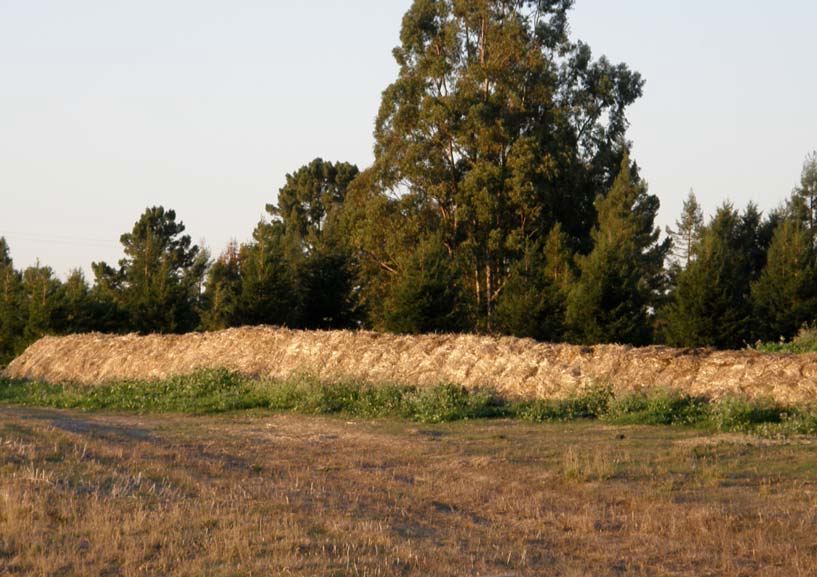 Ted and his staff offer tours and tasting by appointment and definitely take advantage of the opportunity. Call the Littorai office at 707-823-9586 or email info@littorai.com. You must join the Littorai mailing list to access the wines (www.littorai.com/signup.asp). There is limited restaurant placement and the wines are rarely available in retail stores. Ted’s website doesn’t do him justice and offers little information, but he told me the website is going to be revamped shortly.
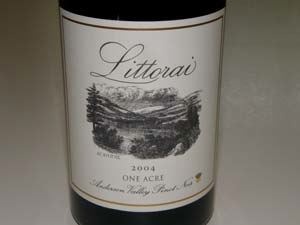 We tasted a number of 2008 Littorai Pinot Noirs which I have previously reviewed in the PinotFile. Besides an Anderson Valley (Les Larmes) and Sonoma Coast appellation blend, Pinot Noir vineyard designates include Platt Vineyard, B.A. Thieriot Vineyard, Hirsch Vineyard, The Haven Vineyard and Pivot Vineyard in the Sonoma Coast, Savoy Vineyard, Cerise Vineyard and One Acre Vineyard in Anderson Valley. Ted’s Chardonnays are classics as well, straddling the line between the flamboyant early drinking California styles that are popular and the more austere, age worthy French white burgundies. The Littorai Chardonnays drink fine early on but also age extremely well. His Chardonnay sources are superb, including Charles Heintz Vineyard, Mays Canyon Vineyard, The Tributary Vineyard and B.A. Theirot Vineyard. Ted uses 25% new French oak for his Chardonnays and 35% new French oak for the Pinot Noirs.
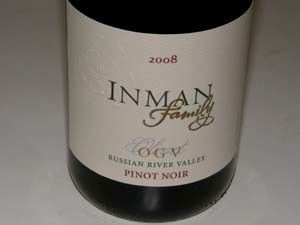 We were lucky to find Kathleen Inman at her winery late Friday afternoon. She graciously offered her current lineup of wines to taste: 2010 Endless Crush Rosé, 2009 Pinot Gris, 2009 Chardonnay, and 2007 and 2008 OGV Pinot Noirs As she poured, she discussed her commitment to eco-friendly practices in her vineyard and winery. Kathleen is an impressive woman who started her winery from scratch nine years ago, and built it into a very popular Russian River Valley destination winery offering consistently top notch wines. For full coverage of Inman Family Wines and a report on my tasting of a Olivet Grange Vineyard (OGV) Pinot Noir vertical, visit the previous issue of the PinotFile (www.princeofpinot.com/article/1096/). The tasting room at 3900 Piner Road is open 11:00-4:00 Thursday through Sunday. If you visit, say hi to my son, Dane, who is working at the winery. The website is www.inmanfamilywines.com.
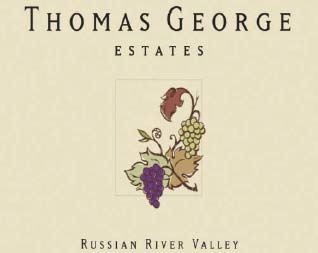 For dinner, we had a special treat. Well-known North Bay chef and caterer, Mateo Granados, offers a series of Tendejon (“A sutler’s tent in a camp” in Spanish) Dinners Thursday and Friday evenings during the summer at various wineries. Mateo brings his crew and a mobile kitchen and serves a sit-down Yucatán-inspired meal served restaurant-style outdoors. Mateo is a Yucatán-born chef who has worked at legendary restaurants such as 42 Degrees, Masa’s, Manka’s Inverness Lodge, and Charlie Palmer’s Dry Creek Kitchen. Our dinner was at Thomas George Estates on Westside Road in Healdsburg. The setting here is magnificent with the winery and grounds tucked among majestic wooded hills. The menu is below. We had the following wines with dinner: 2009 Thomas George Estates Wildwood Vineyard Sonoma Valley Viognier (tropical perfume and flavors, dry, exotic), 2006 Marcassin Marcassin Vineyard Sonoma Coast Chardonnay (big, boozy, well-oaked buttery style), and a magnum of 1995 Williams Selyem Sonoma Coast Pinot Noir (fresh, dark-fruited, vanillin, spice, silky, drinking beautifully). Check Mateo’s website, www.tendejon.com, for dates of upcoming dinners at Amphora Winery, Twomey Cellars, Quivira Vineyards and Winery, and Preston Vineyards. Mateo is at Healdsburg Farmers’ Market on Saturdays and Sebastopol Farmers’ Market on Sundays.
Tendejon de la Calle Spring Menu
Tacones
Atole Grueso con Esparragos
Conejo en salsa de Chihuacle
Especial de la Casa
“Tierra Farm” Baked Strawberry-Rhubarb, Strawberry Ice Cream
SaturdayDehlinger Winery (Sebastopol) The morning was bright and sunny as we arrived at the junction of Highway 116 and Vine Hill Road, the site of Dehlinger Winery and estate vineyards. The octagon-shaped house at the top of the hill, a Russian River Valley landmark, marks the spot. Tom Dehlinger ( DAY-leen-ger) is an icon in the Russian River Valley, shunning publicity, but highly respected for his accomplishments. He was born on the East Coast, but grew up in Berkeley, California, where he earned a degree in biochemistry at University of California Berkeley. He pursued graduate work in enology and food science at University of California Davis, leaving after a year to work in the wine industry, first as a lab technician at Beringer, then in winemaking positions at Hanzell and Dry Creek Vineyard. He was only 26 years old when he set upon a career as an independent winegrower and winemaker in 1973. Early on, Dehlinger had a well-defined idea of how wine grapes should be grown, and realizing that other grape farmers were not conforming to his vision, he decided to plant his own vineyard. He found a neglected hillside property planted to Gravenstein apple trees, bought it with the help of his radiologist father, and with the guidance of Joseph Swan, Warren Dutton and Forrest Tanzer, planted the first 14 acres of vines on his property in the spring of 1975. Dehlinger chose this particular site because of the cool climate and the Goldridge soils. Vineyard planting continued through the early 1900s, reaching a total of 45 acres. Currently several vineyard blocks are undergoing redevelopment including new plantings of Pinot Noir clone 943 and Swan and Calera selections on phylloxera-resistant rootstocks (visit www.dehlinger-replant.blogspot.com/ for more details). Vineyard manager Marty Hedlund has been over seeing the vineyard since 1988. The vineyard has a unique split-canopy vertically shoot positioned Lyre trellis system derived from Bordeaux. Dehlinger chose this system to overcome vine imbalances in the Dehlinger Vineyard. This moveable trellis lifts shoots and leaves up and away from the bank of grapes allowing more light exposure and permitting more precise (but laborious) hand work to manage the shoots and clusters during the growing season. The trellis also minimizes the risk of mold and mildew and permits the vine and grapes to dry out quickly if rain occurs before harvest.
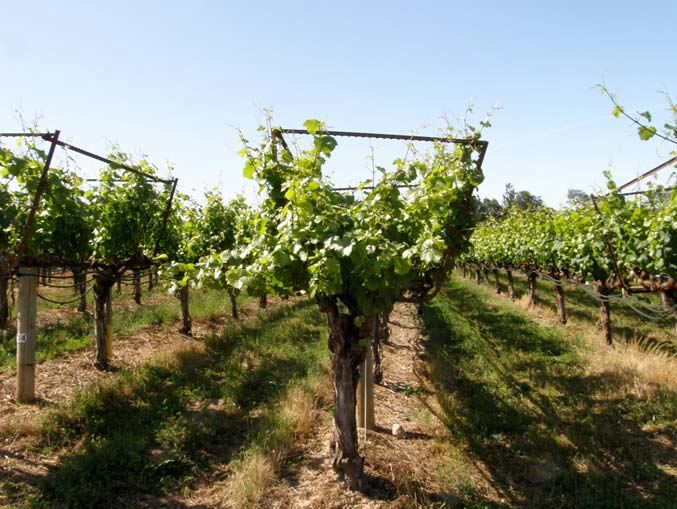 The Pinot Noir plantings are in multiple blocks. Grapes from the lower parts of the vineyard are in Goldridge soil and are referred to and bottled as the Goldridge Vineyard. The hilltop areas feature Altamont soil and are the source for the Estate and special reserve type bottlings. Winemaking is traditional with inclusion of 10% whole cluster in the Estate bottling and the wines are typically exposed to 40% new oak during aging. The Dehlinger Vineyard is one of the very few in the Russian River Valley and the only one in the cooler southern part of the Russian River Valley AVA to grow Cabernet Sauvignon. Dehlinger admits that farming Cabernet Sauvignon has been a challenge in some vintages, but in select years the wines have been superb and highly lauded by the wine press. Chardonnay and a small amount of Syrah are also produced from estate grapes. Total production is about 7,000 cases with most of the wine sold through a mailing list (wwwdehlingerwinery.com). Visitors are welcome by appointment from January through August and there are two Open Houses for mailing list members. An informative newsletter is released each January and July. For over 35 years that Dehlinger has been producing wine, quality and consistency have been the hallmarks. Noted wine critic, Matt Kramer, wrote in 2004, “Dehlinger wines represent an impeccable standard regardless of vintage.” This stalwart winery has never wavered from the vision upon which it was founded. As an added plus, the winery avoids expensive promotion so that prices remain sensible. In 2008, daughters Carmen and Eva Dehlinger returned to Sonoma County to work in the family business; Carmen in customer service and sales and Eva in operations and winemaking. Tom is still active and on the day we visited, he was out in the vineyards working. He is an extremely personable figure, but is fiercely independent and private. His daughter, Eva, in contrast, who received us, gave us a tour, and conducted a tasting, is extremely warm and outgoing. As the second generation becomes more involved, expect to see some modern innovations (Eva has instituted a blog, for example) at the winery. We sat outdoors and sampled several wines, all of which were high quality. The 2007 Estate and 2006 Estate Reserve Pinot Noirs were quintessential Russian River Valley Pinot Noir, exhibiting the vibrant cherry fruit, cola and spice flavors the region is known for. I have not sampled much cool-climate Syrah, but I was taken by the (?2008) Dehlinger Syrah. The wine reminds me of Pinot Noir, yet offers a distinctive flavor profile and I can see why wine lovers get excited about cool-climate Syrah. The (?2008) Cabernet Sauvignon was superb as well, displaying a more reserved, less tannic version of this varietal. (I am not sure on the vintages as I was having such a relaxing time sitting outside, chatting with Eva, and enjoying the wines, I took no notes. Sometimes I just like to enjoy wine for what it is and not worry about the details. Suffice it say, every wine Dehlinger produces is first-rate and you owe it to yourselves to join the mailing list.) Kicking the beautiful soil (below)
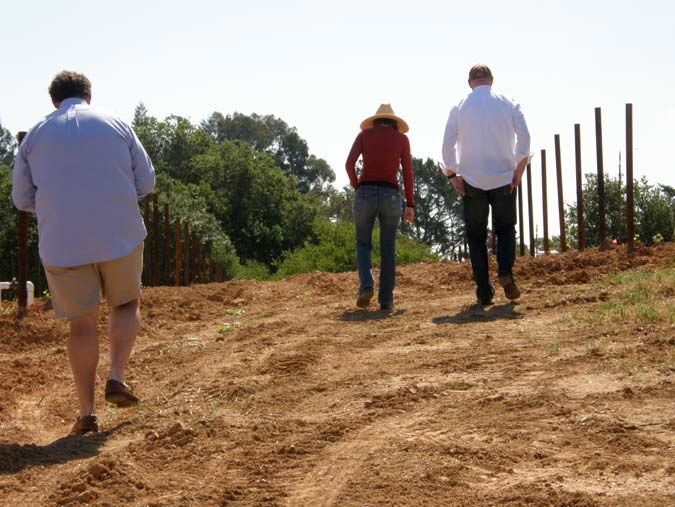 Lynmar Estate (Sebastopol) Lynmar Estate offers one of the most complete Russian River Valley wine country experiences. The modern hospitality center and its terrace look out on lush gardens and vineyards. An on site executive chef allows Lynmar to offer private lunches and dinners, celebrations, receptions, private barbecues, wood-burning oven parties, and interactive culinary classes. Several private tastings and tours are offered by an extremely professional and well-informed hospitality staff. Proprietor Anisy Fritz is often in the visitor center offering her personal touch. All of this would have little substance, however, if the wines did not match up (which is not the case).
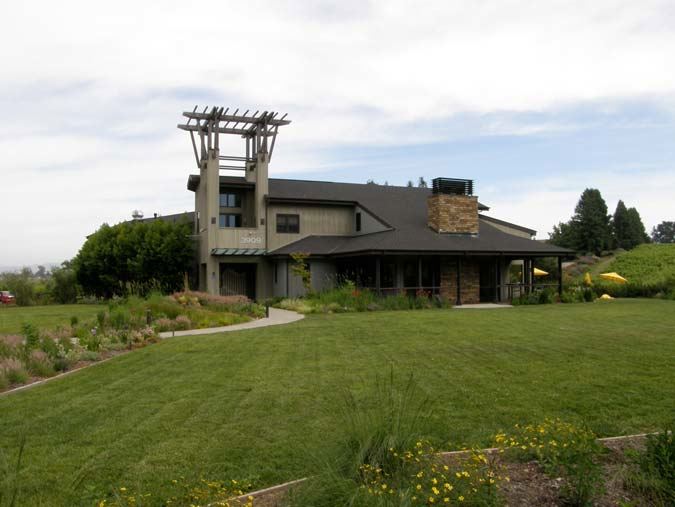 Lynmar has been a consistent producer of wines of excellence since the first 1994 vintage. In recent years the winery underwent a complete renovation with the addition of caves, and the estate vineyards were redeveloped and upgraded to modern viticultural standards. New vineyard sources have also been obtained, allowing for a series of vineyard-designate Pinot Noirs. The wines seemed to be more refined in recent years under the direction of winemaker Hugh Chapelle and consulting winemaker Paul Hobbs. In late 2009, Chapelle left and was replaced by Bibiana Gonzalez Rave, probably the only Columbian-born winemaker in the world. Her years of experience in France have served her well and she is one of the rising stars among California’s new generation of winemakers. I met her and interviewed her for Grape Radio at this year’s World of Pinot Noir and was impressed by her background and knowledge. She earned a Diploma of Enology from the University of Bordeaux and spent time at Chateau Haut-Brion. In California, she has worked at wineries such as Peay Vineyards, Au Bon Climat and Qupe. We were warmly received, offered a glass of the 2010 Lynmar Rosé of Pinot Noir, given a tour of the gardens, and seated outdoors for a special lunch. All the wines served at lunch were stellar and have been previously reviewed in the PinotFile. The menu and wines:
2007 Lynmar Quail Hill Vineyard Russian River Valley Chardonnay
2008 Lynmar Quail Hill Vineyard Russian River Valley Pinot Noir
Lynmar Estate visitor center is open daily at 3909 Frei Road. Visit the website (www.lynmarwinery.com) for more information and to obtain the wines. Limited bottlings are sold primarily through a mailing list. The Bliss House located on the Lynmar Estate 100-acre property is available as a wine country retreat and guests have access to Lynmar Estate’s chef and well as picnics or seated food and wine experiences.

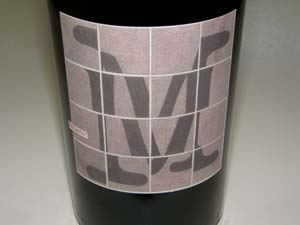 of 2002 Sine Qua Non Hollern’M Shea Vineyard Willamette Valley Pinot Noir. I have had this wine on several occasions and it has never failed to impress me. Although this was a well-cellared magnum, I felt the wine was losing interest. It still offered sumptuous flavors of dark berries, earth, tobacco and mocha in the rich, hedonistic Sine Qua Non style. We shared practically every item on the menu including: Larry Pacini’s House Made Ciabatta Bread with Dry Creek Extra Virgin Olive Oil (unbelievably good), grilled calamari with white beans, pickled onions and arugula, pizza margherita, Nonna’s tomato-braised chicken with sauteed greens and soft polenta, Rosa Maria’s sugo calabrese with lumache pasta, tomato braised pork with oregano, chili and pecorino cheese, and a few other items I don’t remember. Extravagant and decadent! Visit www.scopahealdsburg.com.
SundayDutton-Goldfield (Sebastopol) Founded in 1998 by talented winemaker Dan Goldfield and noted viticulturist Warren Dutton’s son, Steve Dutton, Dutton-Goldfield offers a lineup of exceptional wines including Chardonnay, Pinot Blanc, Gewüztraminer, Pinot Noir, Syrah and Zinfandel. Grapes are sourced from primarily from several Dutton properties in the Russian River Valley and Green Valley appellations with lesser amounts from vineyards in the Sonoma Coast and Marin County sources. Dan Goldfield is an interesting study. He intended to enter medical school but after his brother turned him on to 1969 Burgundies he decided instead to pursue a master’s degree in enology from University of California Davis. He honed his winemaking skills at Robert Mondavi Vineyards, Schramsberg, La Crema and Hartford Court which was created under his direction. Warren Dutton suggested that Dan and Steve form a partnership which was consummated at a Sebastopol pizza parlor with a handshake. Dan is an avid outdoorsman who enjoys hiking, climbing, skiing and bicycling.
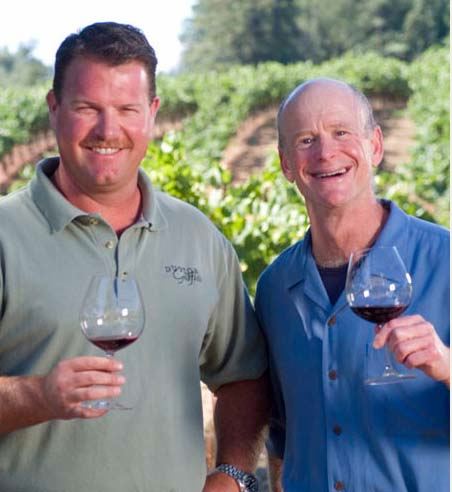 When we visited the new tasting room at the corner of Highway 116 (Gravenstein Highway) and Graton Road, Dan was off climbing a mountain somewhere. This presented no problem as Sarah Kelley, Director of Sales and Hospitality, filled in perfectly and we thoroughly enjoyed our tasting Sunday morning. Pinot Noir sources include Dutton Ranch (Russian River Valley), Freestone Hill Vineyard (Russian River Valley), Devil’s Gulch Vineyard (Marin County), Sanchietti Vineyard (Green Valley) Emerald Ridge (Green Valley) and McDougall Vineyard (Sonoma Coast). If you like your Pinots with modest alcohols, bright acidity, layered fruit flavors and admirable balance, Dutton-Goldfield’s offerings are for you. Dutton-Goldfield wines are available through the winery’s online store and mailing list. An informative email newsletter is offered frequently (www.duttongoldfield.com). The tasting room is open daily from 10:00 to 4:30.
2009 Dutton-Goldfield Dutton Ranch Russian River Valley Pinot Noir 13.5% alc., pH 3.61, TA 0,63, 2,892 cases, $38. This wine represents the character of Dutton Ranch vineyards in the cooler areas of the Russian River Valley and in particular, the Green Valley. Vineyards include Maurice Galante, Marty’s, Silva, Morelli Lane and Fox Den. 100% de-stemmed, 5-day cold soak, aged 10 months in 40% new French oak barrels. · An appealing wine with a nose replete with aromas of blackberries, black cherries and spicy oak and flavors of black plums, blackberries and baking spice. Juicy and moderately plush on the palate with an impressively long finish. Very good.
2008 Dutton-Goldfield Cherry Ridge Vineyard Green Valley of Russian River Valley Syrah 13.7% alc., pH 3.61, TA 0.68, 370 cases, $35. Located on the western side of Green Valley just north of the Petaluma Wind Gap. At 900 feet, 3 acres of Syrah are planted to four clones in an area temperate enough to ripen Syrah. 100% de-stemmed, 5-day cold soak, aged 20 months in 40% new French oak barrels. · This cool-climate Syrah is consistently one of California’s best. Dark reddish-purple color in the glass. Aromas are bright and intense, offering notes of black cherries, spice and white pepper. Impressive mid palate intensity with black cherry flavors really standing out and following through to the generous finish. The tannins are well-proportioned and the acidity lifts the fruit to impressive heights of vibrancy. I am slowly becoming a fan of cool-climate Syrah because of its kinship to Pinot Noir in style. Very good (+).
2009 Dutton-Goldfield Morelli Lane Vineyard Russian River Valley Zinfandel 14.3% alc., pH 3.58, TA 0.64, 214 cases, $40. This 19th century planting is located north of Occidental on the far western edge of the Russian River Valley appellation. The grapes come from a dry farmed, head trained 1.8-acre block that is left of an ancient vineyard. Left unfarmed for years, the Duttons revived the vineyard in 1995. Its cool proximity to the coast gives this wine exceptional brightness and moderate alcohol. 100% de-stemmed, 7-day cold soak, gentle punchdowns, aged 16 months in 40% new French oak barrels. Dutton-Goldfield is only the winery making Zinfandel from this vineyard. · An elegant style of Zinfandel with appealing aromas and flavors of cherries, raspberries, anise, spice and vanilla. The tannins are soft and restrained making for easy drinking. A Zinfandel for Pinot lovers. Very good.
We wrapped up the Immersion Weekend over lunch at this beautifully situated winery and tasting room. From the terrace, one can see manicured vineyards, old hop kilns, and majestic homes and ponds. The winery’s Russian River Valley Pinot Noir Rosé, “Patio Pink,” was the perfect accompaniment to our picnic. I brought
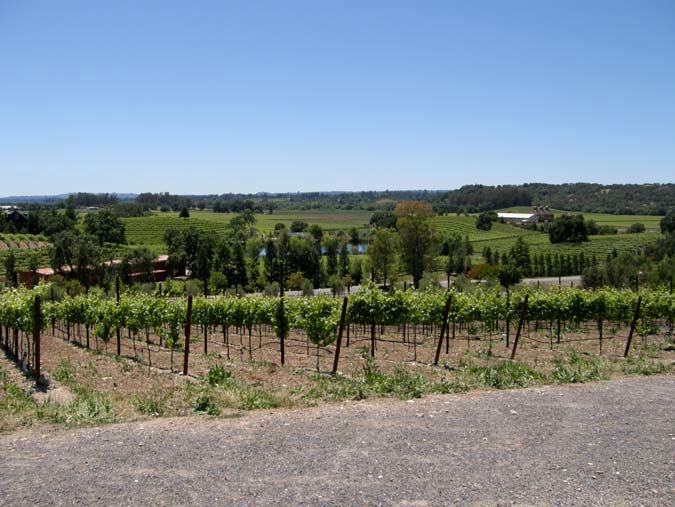 sandwiches and salads from Fresh by Lisa Hemenway, a superb gourmet market and eat in and take out deli on Mountain Hawk Drive in Santa Rosa. Hemenway is a chef who ran Lisa Hemenway’s Restaurant and Lisa Hemenway’s Bistro in Santa Rosa for many years. She was the original Sous Chef and Pastry Chef for John Ash & Co. This is the place (or Chloe’s in Santa Rosa) to go for picnic supplies before heading out to tour Russian River Valley wineries. Nothing better than a BLT with avocado on seeded sour dough with Cherrywood smoked bacon and a refreshing, cold Rosé.
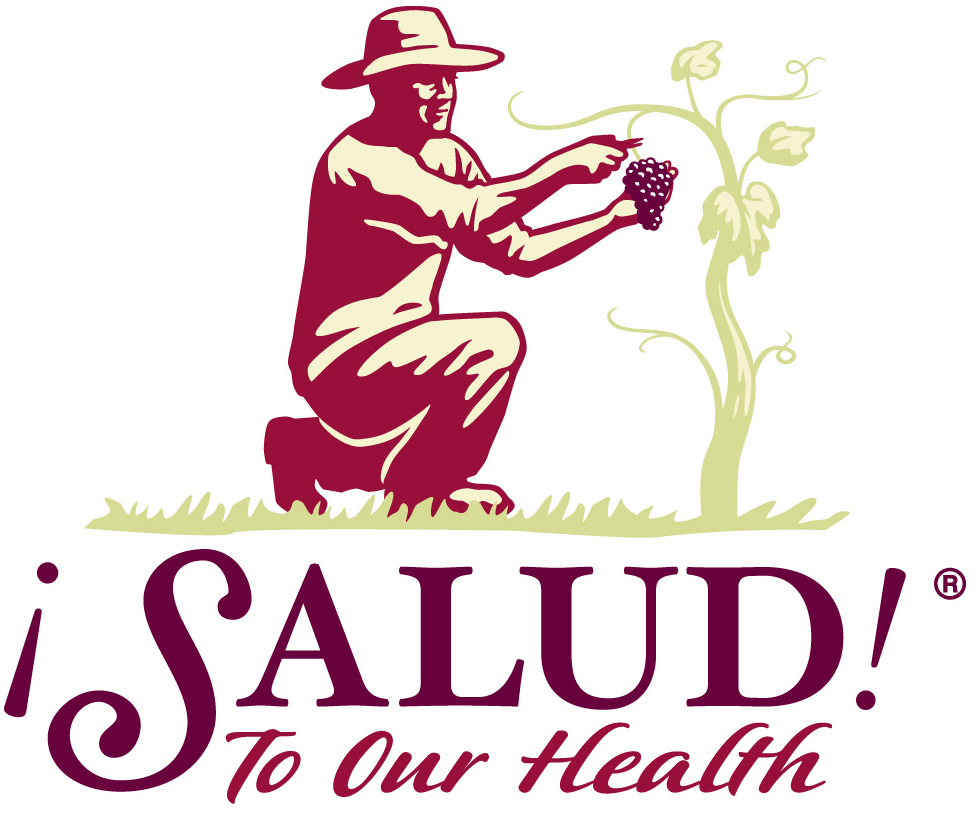
Alysian Wines by Gary FarrellSome consider Gary Farrell the father of Russian River Valley Pinot Noir because he was one of the first Pinot Noir winemakers in the region to rise to prominence. Growing up in Southern California, Farrell was a dedicated surfer who decided to continue his education at Sonoma State University, where he majored in political science. He soon acquired an interest in wine, and landed a job at Davis Bynum Winery on Westside Road. Farrell began as a cellar rat at Davis Bynum Winery working under Davis Bynum and Bynum’s son, Hampton. He soon developed relationships with Russian River Valley pioneers Tom Dehlinger, Joe Rochioli, and Robert Stemmler, but his winemaking skills were largely self-taught. Farrell become the winemaker at Davis Bynum in 1978. Bynum had built the first winery on Westside Road and produced Pinot Noir from Joe Rochioli’s first crop. The 1973 Davis Bynum Winery Rochioli Vineyard Pinot Noir was the first Russian River vineyard-designated Pinot Noir although the label read “Russian River,” not the Russian River Valley. From 1973 until 1981, Davis Bynum Winery was the only one to receive grapes from Rochioli Vineyard. Bynum could not afford to pay Farrell much for his services, so Farrell launched his own eponymous label in 1982 with the release of 50 cases of Rochioli Vineyard Pinot Noir. The wine sold for $80 a case and much of it was hand-delivered to local retailers and customers. The wine became one of the most decorated wines of the vintage. The same year, Farrell made the inaugural Pinot Noir for Rochioli Vineyard and Winery, trading winemaking for grapes for his own inaugural release, and for a few years served as a consultant assisting in the planning and construction of the Rochioli Winery. This close relationship continues to this day with Gary Farrell Vineyards & Winery and Farrell’s newest label, Alysian, receiving grapes annually from Rochioli Vineyard, the latter on a handshake basis. Farrell was to produce the inaugural wines for Zinfandel specialist Limerick Lane and Moshin Vineyards on Westside Road, among others. He was adept at making all varietals and there was considerable interest in Chardonnay, Cabernet Sauvignon and Zinfandel in the 1980s, but Farrell’s true passion was Pinot Noir. He foresaw the untapped potential for Pinot Noir in the Russian River Valley. I enjoyed many Gary Farrell Pinot Noirs from the mid 1980s, but a 1987 Gary Farrell Russian River Valley Pinot Noir made an indelible impression on my wine psyche at a time when my love of Pinot Noir was in its formative years. Gary Farrell Pinot Noirs offered elegance, intense and layered flavors, low alcohol levels, and bright acidity, all beautifully exemplified in this wine. I still have the label from this wine:
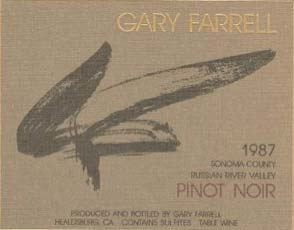 Farrell methodically built the size and reputation of his brand and in 1998 joined with business partner William Hambrecht to build his own Pinot Noir and Chardonnay production facility on Westside Road. Gary Farrell Vineyards & Winery was highly successful and was sold in 2004 to Allied Domecq. Later it was acquired by Fortune Brands, and subsequently by Ascentia Wine Estates. The rigors of producing wine in large quantity under corporate ownership took its toil on Farrell. H felt he was losing a close connection to all phases of winemaking, and in 2004 sold his namesake brand and winery. Farrell remained as a consultant, but left the winery in 2006 to return to his roots as a producer of small lots of Pinot Noir from the regions finest vineyards. He partnered again with William Hambrecht to found a new label, Alysian (ah-liss-ee-uhn). Alysian is of Greek origin and refers to an endeavor arising from intuitive creativity and artistic resolution. The winery’s appropriate logo is an ancient mark referencing a return to one’s center or beginning. Planned production is about 3,500 cases of primarily Pinot Noir with smaller lots of Chardonnay, a modest output that allows him to indulge in his love of winemaking, yet enjoy other passions such as golf, travel and car collecting. A property has been set aside for a new winery at the Floodgate Vineyard along Trenton-Healdsburg Road. Farrell quietly launched Alysian because of non compete agreements. These agreements are expiring and he is now becoming more of a spokesperson for the label. I recently met Farrell for the first time, chatting and sampling some of his marvelous 2008 Pinot Noirs at the Mayacamas Golf Club in Santa Rosa. We were accompanied by Denise Sanders, a Partner and CEO of Alysian Wines. Farrell is very soft spoken, calm and polite with an attractive smile and a golf tan that belies his age. It has been my observation that a winemaker’s wines often reflect the winemaker’s personality and I think that is definitely the case here.
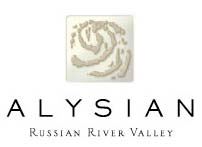 The vineyards that Farrell sources for Alysian are among Russian River Valley’s finest.
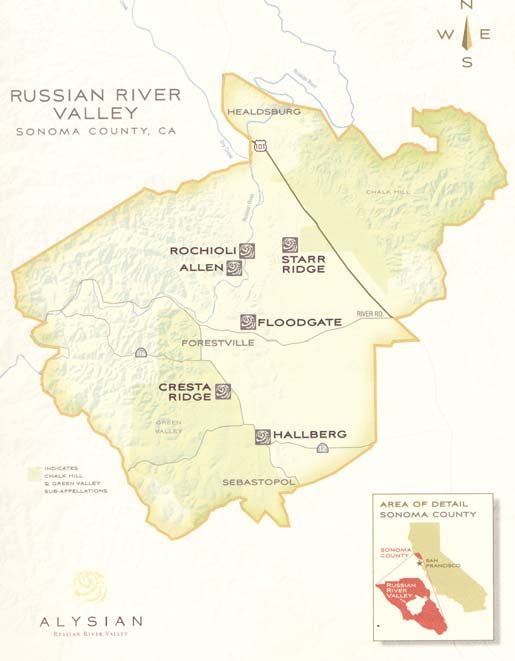 Here are the current releases. The wines are sold through a mailing list and through the winery’s website store. Prices are commensurate with the high quality. These are world-class Pinot Noirs in every sense.
I sampled the following four Pinot Noirs with Gary Farrell. 2008 was a challenging vintage with sunburn a major problem. Significant amounts of fruit had to be dropped and sorting was exhaustive, with hand sorting both prior and after stem removal. The resulting wines possess more finesse than the more highly extracted 2007 vintage wines and embrace the style of winemaking that Farrell prefers.The grapes are 100% de-stemmed because Farrell prefers to pick earlier (average Brix in 2008 was 23.9 to 24.5 degrees) and wants to avoid the bitter tannins that green stems can impart to the finished wine. A 3 to 5-day cold soak is followed by fermentation with inoculation of Assmanshausen yeast and three daily punch downs. New oak is matched to the intensity of the fruit with 30%-45% new tight-grain French oak the rule. Elevage lasts 10-14 months. Final pHs are in the low range. Farrell has always remained true to his stylistic goals, preferring wines that are elegant in personality, possessing restrained tannins and bright acidity.
2008 Alysian Russian River Selection Pinot Noir Moderately light reddish-purple color in the glass. Shy but pleasing array of red fruit aromas including strawberry, cherry and cranberry. Soft and elegant on the palate with bright flavors of Bing cherries, baking spices and cola. A beautiful wine with bright acidity that drives the refreshing finish. Very good. · Moderately light reddish-purple color in the glass. Shy but pleasing array of red fruit aromas including strawberry, cherry and cranberry. Soft and elegant on the palate with bright flavors of Bing cherries, baking spices and cola. A beautiful wine with bright acidity that drives the refreshing finish. Very good.
2008 Alysian Hallberg Vineyard Crossroads Green Valley of Russian River Valley Pinot Noir 14.4% alc., pH 3.46, TA 0.67, 160 cases, $55. This vineyard is located in a cool region with Goldridge sandy loam soil and was developed 10 years ago by noted Sonoma County viticulturist Kirk Lokka. 50% Dijon clone 777 and 50% Cruz Clone. Aged 11 months in 45% new and 55% one and two-year-old French oak barrels. · Moderate reddish-purple color in the glass. Shy aromas of black cherries, red berries, spice, sandalwood and forest floor. Generously flavored with mixed berries clothed in fine-grain tannins and framed by balancing acidity, offering a soft, silky and sensual mouthfeel and a finish that is ridiculously long. In one word, terrific. Very good (+).
2008 Alysian Rochioli Vineyard Allen-Rochioli Blocks Russian River Valley Pinot Noir 14.3% alc., pH 3.44, TA 0.665, 159 cases, $65. Dijon clones 115 and 777 and Pommard 4 from Rochioli Vineyard and Dijon clone 777 from Allen Vineyard (farmed by Rochioli). Aged 14 months in 40% new French oak barrels. · Moderate reddish-purple color in the glass. With swirling, exotic aromas emerge including scents of wild berries, black cherry tart and wood spice. Rich and bold on the palate with flavors of dark red Pinot fruits that coat the mouth, persisting on the invigorating finish that delivers a zing of acidity. This is a serious, potentially orgasmic wine that needs several years in the cellar. Very good.
2008 Alysian Rochioli Vineyard River Block Russian River Valley Pinot Noir 14.3% alc., pH 3.46, TA 0.675, 233 cases, $65. Dijon clones 115 and 777. Aged in 45% new French oak barrels for 14 months. · Alluring scent of fresh ripe raspberries and plums. Striking intensity on the palate of berry and plum flavors which coat every nook and cranny, persisting on the soft ending. The tannins are supple, the bright acidity provides vim and vigor, and the whole package is beautifully balanced. Approachable now, but will be a cause for celebration a few more years down the road. Very good (+).
Emtu Estate WinesJohn and Chris Mason lead double lives as dedicated servants for humanitarian causes and winegrowers and winemakers. Together they craft a single estate Pinot Noir from a dry farmed, 2-acre certified organic vineyard located in Forestville at the juncture of the Russian River Valley and Green Valley appellations of Sonoma County. They live on their property, farm their adjacent estate Labyrinth Vineyard, and control all the winemaking. That in itself is quite an accomplishment, but the Masons have looked beyond grape farming for self-fulfillment. The Masons both had the sir name Mason before marriage but were unrelated, thus the derivation of the name Emtu, a phonetic spelling of M2. Jon is a retired paramedic and Chris a retired health care worker with a master’s degree in dietary science, and since 1999 they have been international relief workers. Each year during the winter, they close up the farm as the vines lie dormant and the wine rests in barrels, and travel to a foreign country where their skills are most needed. During the last few years, they have traveled to regions suffering disasters in Peru, Thailand, Sumatra, Kyrgyzstan and Haiti. In 2005, the Masons founded the Labyrinth Foundation for Disaster Relief to allow them to operate independently or in cooperation with other aid organizations. All profit from the sale of Emtu wines goes to this charitable foundation. The Labyrinth Vineyard was planted to Dijon clone 115 and Pommard 4 and 5 in 1999 and 2003. The vines are rooted in deep Goldridge soil and grafted onto 101-14 rootstock. Each vine is cane pruned individually and every year each vine is carefully assessed to determine the appropriate number of buds to be left as fruiting wood. Multiple passes through the vineyard allow for shoot thinning and positioning to ensure optimal canopy density. A small labyrinth pattern of vines was planted in one corner of the vineyard leaving a small central space fallow that serves as a serene place of contemplation among the vines. John and Chris (shown below in front of their wine cellar) have honed their winemaking skills and refined their style over many years. Their first commercial release of Pinot Noir was in 2004. The 2007 Emtu Pinot Noir is still a staff favorite at Chez Panisse in Berkeley. The 2008 vintage is just now being released. The frost in 2008 reduced the crop by 50% so only 144 cases are available.
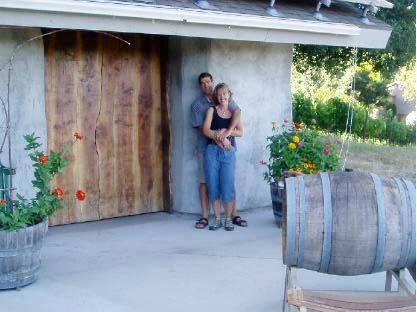 Visitors are welcome for a private tour and tasting (707-887-1239). The wines are available by phone or email (jrm1023@hotmail.com) and in selected wine retailers in the North Bay area.
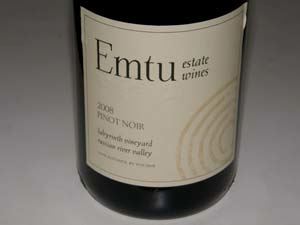 2008 Emtu Labyrinth Vineyard Russian River Valley Pinot Noir 14.0% alc., 144 cases, $40. · Moderate reddish-purple color in the glass. Demure aromas of deep, dark red cherries and berries with a complimentary hint of oak. More boldness and intensity than the 2007 vintage, offering a moderately rich mid palate panoply of fresh Bing cherry, raspberry, and red currant flavors with a hint of cola and anise. The ripe tannins add modest structure, the mouth feel is silky smooth and the wine’s bright acidity leads to a pleasingly crisp finish. This is a very sensual wine that can work beautifully on its own or compliment any feast.
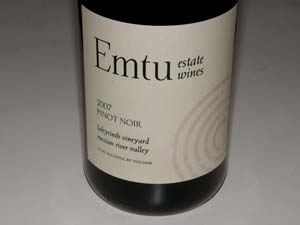 2007 Emtu Labyrinth Vineyard Russian River Valley Pinot Noir 14.2% alc., 275 cases, $36. · Medium reddish-purple color in the glass. Interesting and complex nose offering aromas of cherries, strawberries, prickly pear and spiced apple, developing over time in the glass a subtle green note and a hint of roasted fruit. Appealing core of dark red cherries and berries with accents of cherry cola and earth. Nicely balanced and sporting an appealingly soft elegance. A solid wine. Good (+).
Tasting Crushpad-Produced Pinot NoirsCrushpad is a custom winery for small-scale labels that was founded by current CEO Michael Brill in 2004. Crushpad was founded by current CEO, Michael Brill. The opportunity to assist in the crafting of small lots of wine (50 to 2,500 cases) has attracted many wine enthusiasts and more than 5,000 wines have been produced at Crushpad (1 out of every 100 wines sold in the United States). Crushpad is the only wine services company that provides a complete solution for winemaking, compliance, fulfillment, design, marketing and e-commerce with a simple, all-inclusive pricing model. Crushpad moved to the Silverado Trail Wine Studios in Napa Valley over a year ago, but has recently moved again to downtown Sonoma. Bill Foley, owner of Sebastiani Vineyards in Sonoma, has made a major investment in Crushpad, allowing Crushpad to move its primary winemaking facility to a dedicated portion of the historic Sebastiani Winery located a few blocks from Sonoma Plaza at 389 4th Street East. The latest move will allow Crushpad to significantly expand and improve its winemaking capabilities and allow larger groups to partner and collaborate on the production of custom-made barrels of wine using the online social winemaking platform on www.CrushpadWine.com. In addition, a tasting bar will be opened later this year at this new location, allowing more than 100 Crushpad clients the opportunity to offer their wines for sale to Sonoma visitors. The tasting bar will incorporate interactive wine education stations and automated wine dispensers. The new facility will also offer wine blending and sensory analysis classes. Crushpad is able to access fruit from well-regarded vineyards throughout California and Oregon. Notable Pinot Noir vineyards include Brousseau (Chalone), Doctor’s (Santa Lucia Highlands), Hayley (Annahala - Anderson Valley), Londer (Anderson Valley), Rita’s Crown (Sta. Rita Hills) and Split Rock (Sonoma Coast). The full list of vineyards is listed at www.CrushpadWine.com/vineyardlist. I recently visited Crushpad at Sebastiani Vineyards in Sonoma and tasted a number of Crushpad-produced Pinot Noirs with current winemaker Adam Smith who joined Crushpad for the 2010 vintage. His background includes winemaking stints at Craggy Range in New Zealand and Bethel Heights, Domaine Serene and Shea Wine Cellars in Oregon. Smith focuses on working with clients who are making Pinot Noir, Chardonnay and Syrah. Kian Tavakoli (formerly Clos du Val and Opus One) is the Chief Winemaker at Crushpad. Smith’s biggest challenges initially were putting faces to the wines and crafting a wide range of wine styles based on client preferences. For instance, 250 different Pinot Noirs were produced in 2009 at Crushpad, a vintage that Smith finished. His current stated goal is to work very closely with clients through constant feedback, a goal that was more achievable in the 2010 vintage as he became familiar with the program. I sampled nine 2009 vintage Pinot Noirs and 2 2010 vintage barrel samples. My general impression was that there was good diversity among the wines, the wines were technically sound, but they were of average quality with some modest standouts among the 2009 Pinot Noirs. Retail pricing of the wines is determined by the clients, ranging from $34-$55. I felt the wines priced above $40 did not offer a level of quality commensurate with the asking price. In today’s economy and prevailing Pinot Noir wine marketplace, a Pinot Noir priced above $40 must really delivery an exceptional drinking experience and often an established producer or brand name is required as well. That said, with Smith at the helm and a new modern winemaking facility at his disposable, the wines will only get better. The 2010 barrel samples showed exceptional promise.
2010 Amber Ridge Vineyard Russian River Valley Pinot Noir Barrel Sample 85% Pommard, 15% 115. Native fermentation, 25 day maceration. · Moderately deep reddish-purple color in the glass. Fruity nose displaying aromas of plums and raspberries. A softly textured, full-bodied wine that has a dense core of ripe fruit but currently lacks nuance. Should take on more personality after it is bottled.
2010 La Encantada Sta. Rita Hills Pinot Noir Barrel Sample Clones 777 and 667. 40% whole cluster, native fermentation. · A striking wine with a lovely mix of spiced red and black fruits that make a statement upon entry and hold forth strongly to the long finish. Impeccably balanced with charm to spare. Only sexual analogies can do this wine justice.
2009 Waveland Doctor’s Vineyard Santa Lucia Highlands Pinot Noir 14.3% alc., $34. Crafted under the direction of Stuart Ake. · Moderately light reddish-purple hue in the glass. Shy initially, but picks up aromatic intensity in the glass over time, offering aromas of red raspberries, cranberries and cherries. A soft, light and simple wine featuring red fruits, an undertone of oak and herbs, and supple tannins. An easy drinker. Decent (+)
2009 Aeshna La Encantada Sta. Rita Hills Pinot Noir 14.1% alc., $39. Crafted under the direction of Brian Emmett. · Moderate reddish-purple color in the glass. Plenty of ripe fruit in this wine but little nuance. Flavors of red plums and raspberries with hints of savory herbs, offering generous oak, soft tannins and a short, slightly hot, finish. Decent.
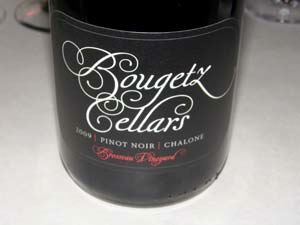 2009 Bougetz Cellars Brousseau Vineyard Chalone Pinot Noir 14.2% alc., $39. Crafted under thedirection of Tom Bougetz. · First bottle corked. Second bottle reviewed. Moderately deep reddish-purple robe in the glass. Appealing aromas of well-spiced black berries. Generous core of perfectly ripe, sweet, and earth-kissed black cherries and black raspberries lingering on the fruit-driven, slightly hot, finish. Good.
2009 Damian Ray Doctor’s Vineyard Santa Lucia Highlands Pinot Noir 14.3% alc., $39. Crafted under the direction of Jon Tarabini. · Moderately light reddish-purple color in the glass. Pleasant perfume of strawberries, spice and red hard candy. A fruity, somewhat simple wine with a core of red berries and red cherries. Soft in the mouth with bright acidity, restrained tannins and a hint of alcoholic heat on the finish. Good.
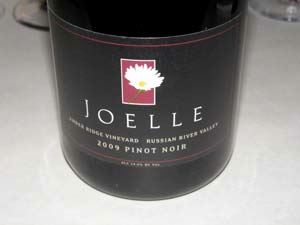 2009 Joelle Amber Ridge Vineyard Russian River Valley Pinot Noir 14.0% alc., $39. Crafted under the direction of Chris Winslow. · Moderately light reddish-purple hue in the glass. Bright scent of crushed red berries with a touch of forest floor and barnyard. Soft and appealing on the palate with a delicious core of mixed Pinot fruits, supple tannins, and a pleasing hint of oak on the generous and persistent finish. Very good.
2009 Townley La Encantada Sta. Rita Hills Pinot Noir 14.3% alc., $48. Crafted under the direction of Randy Bennett. · Moderately deep reddish-purple color in the glass. Charming nose showing off plenty of red fruit, especially Bing cherries. Nicely composed and medium weighted with classy dark red fruit, balanced ripe tannins, and a slightly shallow finish. Good (+).
2009 Calicaro Split Rock Vineyard Sonoma Coast Pinot Noir 14.6% alc., $54. Crafted under the direction of Dave Ball. · Moderately deep garnet color in the glass. The nose is aromatically shy with only faint whiffs of dark fruit and oak. Moderately intense flavors of sweet black raspberries and plum reduction sauce with gentle oak, supple tannins and a dry, slightly warm, finish. Decent.
2009 Lagniappe Wines Split Rock Vineyard Sonoma Coast Pinot Noir 14.2% alc., $55. Crafted under the direction of Jean-Marie Truchard. · Moderate reddish-purple color in the glass. A floral nose with notes of savory herbs and subtle oak. Light in weight with soft tannins. Pleasing flavors of dark red berries and spice with some persistence on the fruity finish. Good.
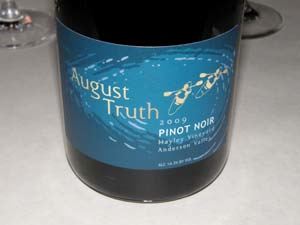 2008 August Truth Hayley’s Vineyard Anderson Valley Pinot Noir 14.3% alc., $38. Crafted under the direction of Tom Harlan. · Moderately deep ruby color in the glass. Lovely aromas of black cherry pie and baking spices. Soft and velvety on the palate, expanding in the mouth with generous and hi-tone flavors of black cherries, finishing with a kiss of oak. Good (+).
Pinot BriefsCobb Family Wines Closing Mailing List Soon Due to the large number of signups in the past few years and the response to recent releases by customers, the press and sommeliers around the country, Ross Cobb has decided to close the list soon and begin a Waiting List for new requests for wines. Cobb wines are made in small quantities and Ross wants to ensure that current Mailing List members have access to their full allocations. In other words, the goal is to guarantee that Cobb Family Wines will be able to continue to support those who have loyally supported them. The website is www.cobbwines.com. Oregon Wine History Archive Linfield College in McMinnville, Oregon, recently established an archive that will house irreplaceable historical documents and memorabilia from early winegrowers in the Willamette Valley. Primary source documents will include growers’ exploratory notes about winemaking, early promotional materials, land-use maps, meeting notes, and newsletters and articles from national and international press. Winegrowers represented in the collection include David Adelsheim of Adelsheim Vineyard, Dick Erath of Erath Winery, Diana and David Lett of Eyrie Vineyards, Dick and Nancy Ponzi of Ponzi Vineyards, Myron Redford of Amity Vineyards, and Susan and Bill Sokol Blosser of Sokol Blosser Winery. Linfield has secured a $1 million endowment to establish the Linfield Center for the Northwest (www.linfield.edu.com), which sponsors, in part, research and educational outreach connected to the Oregon wine industry. Linfield faculty and students have collected oral histories and digitized historical documents. A documentary about the history of the International Pinot Noir Celebration held each year on the Linfield campus is being produced as well. For more information about the Archive, contact Linfield Library Director Susan Barnes Whyte at 503-883-2517 or swhyte@linfield.edu. Below: Yamhill County winegrowers 1983 (courtesy of Oregon Wine History Archive).
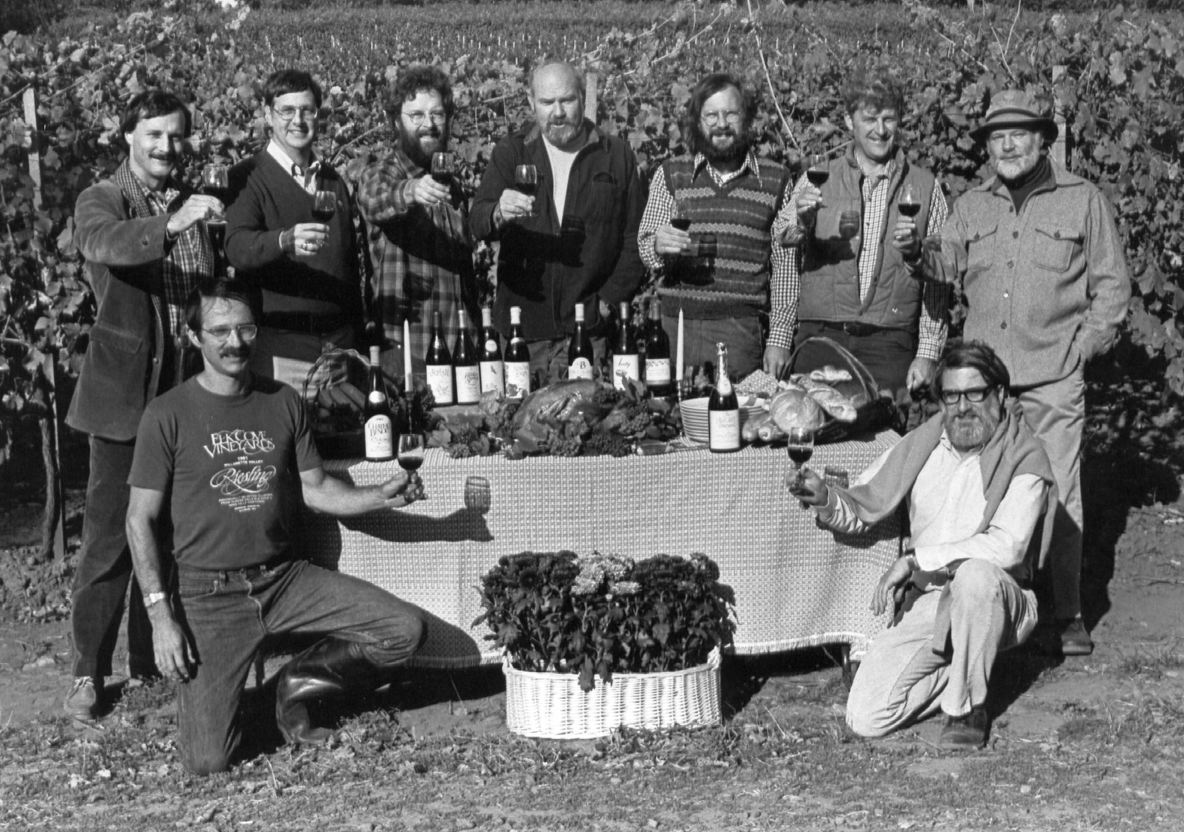 Dry Creek Kitchen Sonoma County Wine Pioneer Series One Sunday a month an interactive seminar, wine tasting and 3-course dinner will be presented at Dry Creek Kitchen in Healdsburg. Cost is $65 per person (not including tax and gratuity) and seminar wines may be purchased to accompany dinner at retail price. The schedule includes: Sonoma County Viognier (August 7), Old Vine Zinfandel (September 11), Comparison of Pinot Noir from Three Regions (October 16), and Sonoma County Syrah (November 6). For information, visit www.CharliePalmer.com. Fine The American Wine Magazine Fine is a fairly new publication dedicated to the world’s greatest wines, wine personalities, tasting notes, gourmet food and the luxurious lifestyle. The magazine had over 8 million readers in 6 languages in 2010. The editors-in-chief and founders are Pekka Nuikki and Juha Lihtonen. Clients of Acker Merrall & Condit receive the magazine free by email. Visit www.fine-magazines.com for more information. Both paper and digital version subscriptions are available.
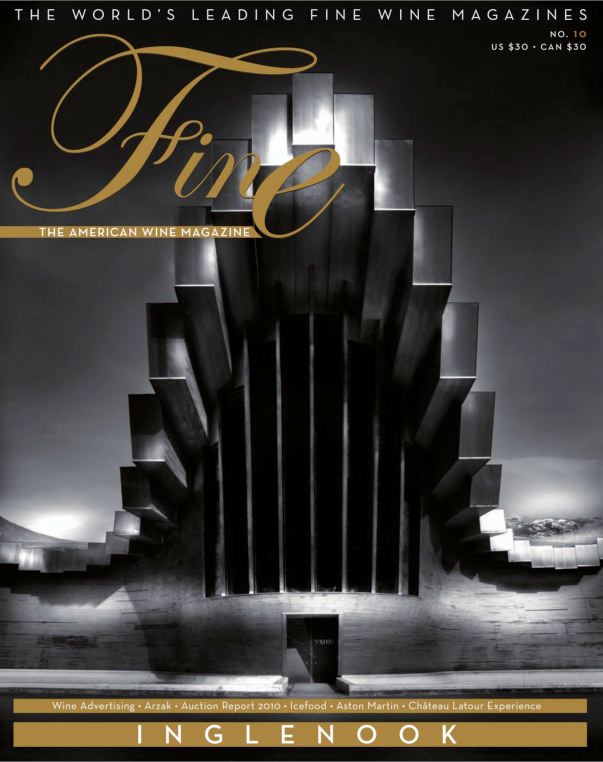 MacPhail Family Wines Joins The Hess Collection Winemaker James MacPhail is joining The Hess Collection by bringing along MacPhail Family Wines while continuing his work as the founding winemaker for Sequana Vineyards. The Hess Collection will acquire the MacPhail Family Wines brand as well as existing inventory. MacPhail Family Wines was founded in 2002 as a Pinot Noir specialist, sourcing grapes from Sonoma County and Anderson Valley. Sequana Vineyards, which debuted in 2007, focuses on cool climate growing regions, primarily Green Valley of Russian River Valley and the Santa Lucia Highlands. MacPhail’s output is 4,000 cases annually, priced at $40 to $60, while Sequana produces 11,000 cases each year, priced at $32 to $50. 2011 Sonoma Wine Country Weekend On Labor Day Weekend, September 2-4, 2011, the 4th Annual Sonoma Wine Country Weekend will be held. The event features intimate winery lunches and dinner parties, Taste of Sonoma at MacMurray Ranch, and the Sonoma Valley Harvest Auction at Cline Cellars. More than 150 wineries and over 60 chefs will participate. Tickets are on sale now at www.SonomaWineCountryWeekend.com with special perks and savings for Visa Signature cardholders. Winesong! The 27th Annual Charity Auction and Gourmet Tasting, “Feast For The Senses,” will be presented by the Mendocino Coast Hospital Foundation on September 9 and 10, 2011. Since 1985, the event has raised over $4 million for Mendocino Coast health care. On Friday, September 9, an Anderson Valley Pinot Noir Barrel Tasting will be held at Little River Inn. On Saturday, September 10, the Tasting & Auction will be conducted at the beautiful Mendocino Coast Botanical Gardens. Both live and silent auctions feature wine from prestigious producers like Belle Glos, Dehlinger, Emeritus, Rochioli, Merry Edwards, Williams Selyem, TR Elliott, Dominus, Pahlmeyer, Grace Family Vineyards, Spottswoode, Duckhorn, Joseph Phelps, Caymus, Far Niente, Silver Oak Wine Cellars, Goldeneye, Esterlina, Chateau Latour, Chateau Haut-Brion, Chateau Margaux, Chateau Mouton Rothschild, Vieux Telegraphe, Pio Cesare Barolo, and Prima Petra. Gourmet food will be offered by Mendocino restaurants and more than 90 wine producers from California, Oregon and Washington will be pouring. For tickets, visit www.winesong.org. Oregon House Bill 3280 Winery Event Legislation Oregon passed a law on June 27 2011 allowing wineries zoned EFU (exclusive farm use) and having at least 15 acres of contiguous vineyards to have a tasting room, hold marketing events, and host weddings, celebrations, outdoor concerts and other facility rentals for up to 25 days per year. Permits must be obtained for more than 25 annual event days. Only wineries considered large, that is, those with 130 acres typically producing at least 63,000 cases annually, can have a restaurant on EFU land. Large wineries will still be subject to the same limitation on events and will need permission for the local county to operate more than 25 days a year. Very few Oregon wineries fall into this “large” category. For those of you considering a wedding venue in the Willamette Valley, visit the excellent website of Youngberg Hill at www.youngberghill.com. Youngberg Hill won the 2011 Oregon Bride Magazine award for “Best Sunset Wedding Spot” and “Best All Inclusive Wedding Venue,” and was a finalist as “Best Venue for Large Weddings,” (winners were The Governor Hotel in Portland and Zenith Vineyard in Salem) and “Best Oregon Destination Venue” (winner was Skamania Lodge). View all the winners at www.orbridgemag.com/node/12118. Wine Alcohol Strength Understated A report by www.guardian.co.uk involving 129,000 wines imported into Ontario, Canada (where alcohol content of every incoming wine is checked) revealed that the wines were often marketed as less alcoholic than they really were. The American Association of Wine Economists found that 57% of the wines analyzed were stronger than what was declared on the wine label. The average alcohol content reported was 13.1% while the actual average alcohol content was 13.6%. Bottles from Chile, Argentina and the United States understated the alcohol content most often but all countries on average understated the alcohol percentage. Just under a third of the wines overstated their alcohol content (typically wines with low alcohol content). Some winemakers admitted understating the alcohol percentage for marketing purposes. The study also revealed that the strength of wine throughout the world has increased almost a percentage point in recent years. Between 1992 and 2006, average alcohol percentage in a bottle of wine that entered Canada through Ontario rose from 12.6% to 13.6%. American wine is typically one percentage point stronger than European wines and half a percentage point stronger than Australian wines. Some of France’s Bordeaux wines are now producing wines with high alcohol content up to and over 15%. Stanford University Study on Climate Change A peer-reviewed study (not scrutinized by the larger scientific community yet) from the Woods Institute for the Environment at Stanford released last week and reported in the Los Angeles Times, indicated that in the next 30 years the number of desirable vineyards in California could decrease by 50% because of global warming. Napa and Santa Barbara counties could experience ten more very hot days (95 degrees or higher) during the growing season. The amount of desirable winegrowing land is expected to decrease over the next three decades. Yamhill County in Oregon and Walla Walla County in Washington may benefit from the climate change and experience more optimal growing weather. Coauthor of the study, Noah Diffenbaugh, suggested that vineyards be planted with heat-tolerant vines that can survive up to 45 very hot days and average temperatures of 71 degrees. Trellis systems, irrigation and winemaking techniques may need to be modified as well. The newspaper report quotes figures from the Wine Institute indicating that California’s wine industry generates $16.5 billion, produces more than 5 million gallons per year on 500,000 acres of vineyards, and accounts for nearly 90% of the total wine production in the United States. Wine Spectator Announces Another “Best Ever” Claim Magazines are in business to sell copies so they often resort to hype and outrageous statements to attract buyers. Wine writer James Laube recently announced, “California 2009 Pinot Noirs Might Be Best Ever.” Most wine lovers will gloss over the “Might Be” and latch onto the “Best Ever.” Good for California wineries, but hardly an accurate statement. Except for 2008, California has had a strong run of excellent vintages this century and only recently, 2007 was touted as the “Best Ever.” Do not be seduced by general claims about either good or bad about vintages. Seek out your favorite consistent producers and stick with them, for they will nearly always make very good wine regardless of vintage.
 Outside Lands Music Festival This year’s food, wine and music festival will be held August 12-14 at Golden Gate Park in San Francisco. More than 65 performers including Erykah Badu, Muse, Phish, John Fogerty and Girl Talk, 120 food options, and 30 winemakers will participate. The wine tent called Wine Lands will have wine kegs from Long Meadow Ranch and wines from Kermit Lynch, Hess Collection, Qupe, Navarro, Darioush, West Sonoma Vintners, Wind Gap, Drew, A.P. Vin, Scribe, Claypool and Gloria Ferrer. Projected attendance is 60,000 people per day. For more details and tickets, visit www.sofoutsidelands.com. Oregon Wine Board Economic Impact Report The Oregon Wine Board recently reported in a press release the results of a study conducted by Full Glass Research that showed the economic impact of Oregon’s wine industry nearly doubled to $2.7 billion since the last study in 2005. Wine’s contribution to Oregon’s economy has grown by 93% during a time when the Oregon wine industry weathered the worst consumer recession in its history. Knowledgeable wine consumers are showing an increasing familiarity with Oregon wines. Those who considered Oregon wines of superior quality compared to other wines increased from 42% to 59% between 2005 and 2009. The report stated that Oregon currently has 419 wineries and 849 vineyard owners. In 2010, wine related jobs in Oregon totaled 13,518 and related wages were $382 million. Oregon’s wineries produced 1.7 million cases of wine worth $252 million in 2010 with about half of that being sold to customers outside the state. Oregon enjoys the highest average price per ton of grapes and the highest average revenues per case of finished product. Shipments of Oregon wine into out-of-state distribution increased 94% and direct-to-consumer sales increased 133% since 2005. While California’s grape production grew at a 17% pace over the last five years, and Washington’s by 21%, Oregon’s production was up 38%, trailing only New York’s growth. From www.oregonwine.org. Still Some Seats for Pre-IPNC Dinners Each year on Thursday night before the International Pinot Noir Festival (IPNC) at Linfield College in McMinnville, Oregon, special dinners are hosted by Willamette Valley wineries some of which include winemakers from wineries participating in the IPNC (July 29-31). You can attend these dinners, held throughout the Willamette Valley and in Portland on July 28 without attending IPNC. This year is special because it is the 25th Anniversary of the IPNC and many dinners are offered. Seats are still available for following dinners: Amity Vineyards (al fresco dining, older vintages offered), Anne Amie Vineyards (Counter Culture 2011 with international street food and guests Cobb Wines, Grochau Cellars, Lemelson Vineyards, Mt. Difficulty, Saintsbury, Schone Schlucht, Syncline Wines, Van Duzer Winery, and Weingut Wieninger), Coelho Winery (gourmet dinner featuring cuisine of Wild Pear Restaurant paired with Dave Coelho’s wines), Domaine Serene (tasting of Monogram Pinot Noirs, hors d’oeuvres by Chef Scott Ketterman of Simpatica), The Eyrie Vineyards South Block Vertical 1975-2007 Tasting (guided tasting of every vintage of South Block over four decades, wines never previously shared with the public, 1-4 PM McMinnville Grand Ballroom), J.K. Carriere & Brooks Wines (at J.K. Carriere’s new winery, dinner by Chef Chris Israel of Portland’s Grüner), Johan Vineyards (at owner Dag Sundby’s house overlooking Johan Vineyards), Le Cadeau Vineyard (5-course dinner at Bistro Maison in McMinnville with 2005-2009 Le Cadeau vines), Maysara (multiple course dinner by Chef Giani Respinto of Gianmarco’s, and book signings by Katherine Cole, author of Voodoo Vintners and Jordan McKay, author of Passion for Pinot), Northwest Wines To You (at Red Ridge Farms, twelve northwest wineries, live music, Chefs Jody Kropf of Red Hills Market and Chef Caroline Hamina of Biggio Hamina Cellars), R. Stuart & Co. (at winery’s wine bar in downtown McMinnville, chefs from Aviary in Portland), Remy Wines (winemaker Remy and Chef Charles Drabkin, IPNV guest chef since 2006 offer 5- course dinner benefiting EDCC culinary program), Retour & Hamacher (Lindsay Woodard of Retour, Eric Hamacher of Hamacher Wines and Chef Sunny Jil of The Allison’s Jory Restaurant at The Allison Inn & Spa), Rex Hill (cuisine from Red Hills Provincial Dining, featured guest Paul Pajol of Prophet’s Rock in Central Otago), Scott Paul Wines (Chef Chris DiMinno of Portland’s Clyde Common and Chef John Sundstrum of Seattle’s Lark, winemaker Benjamin Leroux of Comte Armand in Pommard), Sineann at The Joel Palmer House (winemaker Peter Rosback of Sineann), Sineann at Thirst Bistro (in Portland at RiverPlace Esplanade), Soter Vineyards (Chef Daniel Mondok of Genoa Restaurant at Mineral Springs Ranch), Tina’s & Lumos (wines of Dai Crisp and PK McCoy of Lumos at Tina’s Restaurant in Dundee), Torii Mor & Hirsch Vineyards (Chef Paul Bachand of Recipe at Recipe Restaurant), and Youngberg Hill (guests Alexandrine Roy of Domaine Marc Roy, Peruvian food from Andina Restaurant). For details and links to the dinners visit http://www.ipnc.org/thursday.php.
Sulfites in Wine
Although sulfites are perfectly safe for most people, there are selected individuals with asthma and others who are deficient in the natural enzyme to break sulfites down who are particularly sensitive. Reportedly, 8 percent of the world's population is allergic to wine. About 1% of people are sulfite-sensitive, but in asthmatics, the figure is closer to 5%. Steroid-dependent asthmatics are at most risk for a severe reaction. Even among the asthmatic population, however, a relatively high sulfite level exposure is required for a reaction. Since 1985, the FDA has required foods such as wine to indicate on the label the presence of sulfites to alert the small percentage of people to the possible problems associated with consuming sulfite-containing food. Wines with more than 10mg/liter must have a “Contains Sulfites” warning label and only wines with less than 1mg/liter can state “No Sulfites” on the label. The symptoms of sulfite sensitivity are usually mild and consist of a skin rash accompanied by redness, hives, itching, flushing, tingling and swelling. In more sever cases, respiratory symptoms can include wheezing, difficulty breathing, and loss of consciousness. The headaches, stuffy noses, and rosy cheeks that some people develop after drinking red wine are not related to the sulfite content of the wine but probably due to other substances contained in wine such as histamines, tyramine and tannins. These symptoms do not progress to a more serious reaction. Tannins have been shown experimentally to stimulate blood platelets to release serotonin and increased serotonin levels can be associated with headaches. Alcohol itself may be a factor for it is known to precipitate migraine headaches in genetically predisposed individuals. Choosing wines naturally low in tannins, such as white wines, as well as red wines that are lower in tannins like Pinot Noir may reduce the risk of headaches. Drinking wine with food is also helpful. To test out a wine, try a half glass and wait 15 or 20 minutes. If the wine is going to cause a headache, it will likely do so within this time. If there is no reaction, the wine drinker should be fine as long as they imbibe in moderation. Ingesting aspirin, ibuprofen or acetaminophen before drinking may block the “red wine headache syndrome,” but consult your doctor before taking these medications on a regular basis. A 2010 study published in the Journal of Proteome Research discovered that there are 28 glycoproteins in a Chardonnay that are similar to allergens found in other foods. These proteins are derived from the grape itself and created during the fermentation process. A definite casual relationship between glycoproteins and wine allergy have not been established. The hope is that someday the winemaker may be able to remove unwanted allergens without altering the flavor of the wine, creating a low or non-allergenic wine.
|